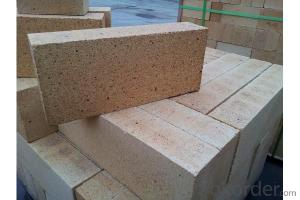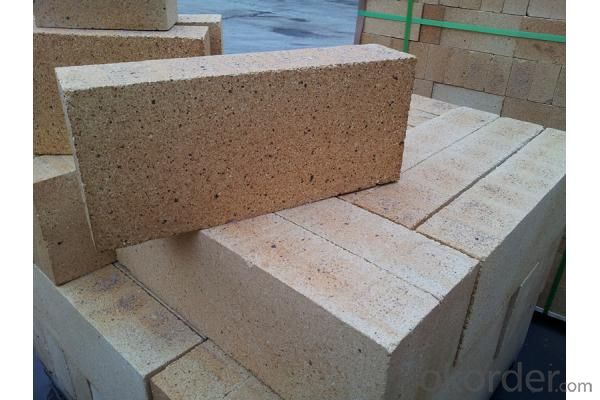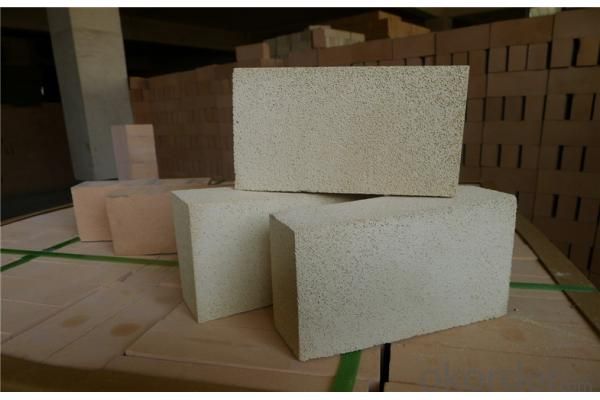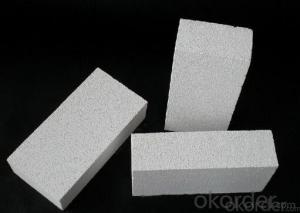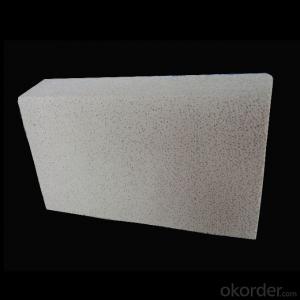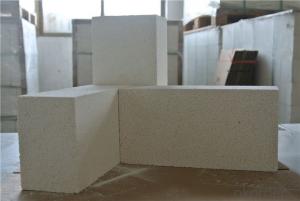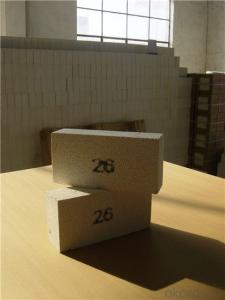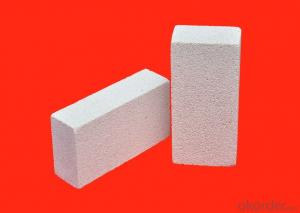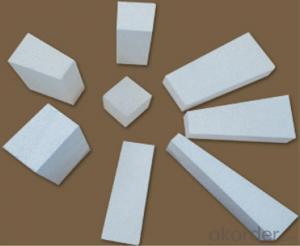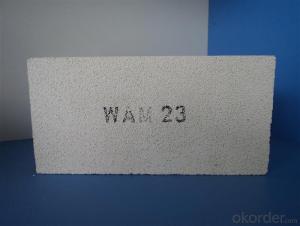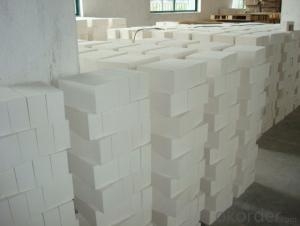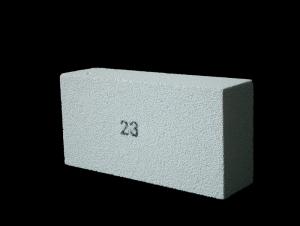Insulating Fire Brick - High Quality Refractory Mullite Insulating Fire Brick
- Loading Port:
- Tianjin
- Payment Terms:
- TT OR LC
- Min Order Qty:
- 10 m.t.
- Supply Capability:
- 10000 m.t./month
OKorder Service Pledge
OKorder Financial Service
You Might Also Like
CNBM conforms strictly to the requirements of ISO 9000 quality control system during the production. MSDS is also available if you want. The thermal insulation fire clay brick meet with the requirements of ASTM & JIS standards. So please stay cool with our quality.
Application
Insulating Fire Brick are used for the lining of converter, alternating current arc furnace, direct Current arc furnace and the ladle slag line, etc.
Insulating Fire Brick Technical index
Brand Quality | JM23 | JM26 | JM28 | JM30 | JM32 | |
Bulk Density (g/cm3) | 0.52 | 0.78 | 0.88 | 1.03 | 1.25 | |
1.2 | 1.6 | 2.1 | 2.5 | 3.5 | ||
Modulus of Rupture (Mpa) | 0.9 | 1.4 | 1.6 | 2.1 | 2.1 | |
-0.5 | 1400℃ -0.4 | 1510℃ -0.5 | 1620℃ -0.9 | 1730℃ -0.9 | ||
Thermal Expansion 1100℃(%) |
0.5 |
0.7 |
0.8 |
0.9 |
1.1 | |
Thermal conductivity(W/m.k)
| 400℃ | 0.14 | 0.27 | 0.32 | 0.41 | 0.49 |
600℃ | 0.16 | 0.29 | 0.34 | 0.43 | 0.50 | |
800℃ | 0.18 | 0.31 | 0.36 | 0.44 | 0.51 | |
1000℃ | 0.20 | 0.33 | 0.38 | 0.45 | 0.53 | |
Al2O3 | 37 | 58 | 67 | 73 | 77 | |
Fe2O3 | 0.7 | 0.7 | 0.6 | 0.5 | 0.4 | |
Equipment
1 unit of Ceramic Abrasive (SG Abrasive) pilot production line
2 units of Compact grain Abrasive pilot production lines
1 unit of high-end coated abrasives (abrasive cloth) production line
2 units of Boron Carbide production lines
3 large flexible crushing and sieving lines for grit production lines
2 units of 2000KVA furnaces for Boron Carbide fusion
6 units of 5000KVA-10000KVA dumping type electric arc furnaces for Brown Fused Alumina fusion
Company Advantage
(1)Long Insulating Fire Brick manufacture history: 25 years manufacturer
(2)Advanced equipment
(3)Diversification of production standards: ISO ANSI FEPA JIS ASTM
(4)Flexible payment: T/T L/C D/P D/A
(5)Professional marketing team and after-sale service
(6)Free sample
FAQs
Q1 |
What’s the transport method? |
A1 | FCL delivery goods with wooden pallet or wooden case by sea; If LCL delivery, must with wooden case; Sometimes need open top, flat rack or bulk cargo. |
Q2 |
What’s the required payment term? |
A2 | Generally 30% TT as the prepayment, 70% TT before delivery. If need, 100% Irrevocable Letter of Credit or negotiation. |
Q3 |
Which country are our products exported to? |
A3 | Apart from entire Chinese market, the US, Russia, Japan, Korea, Australia and some Southeast Asian Nations. |

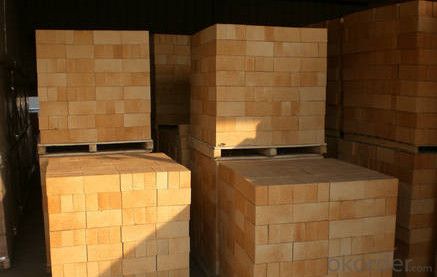
- Q: Are insulating fire bricks resistant to insect infestation?
- No, insulating fire bricks are not resistant to insect infestation.
- Q: Can insulating fire bricks be used in chimneys or flue systems?
- Insulating fire bricks have the ability to be utilized in chimneys or flue systems. They have been specifically engineered to endure high temperatures and offer exceptional insulation. Their typical usage involves situations where heat retention or reflection is necessary, such as in chimneys or flue systems. These bricks possess the capability to withstand temperatures of up to 3000°F (1650°C), which makes them highly suitable for implementation in environments with extreme heat. In addition, their insulation properties aid in reducing heat loss, improving energy efficiency, and preventing harm to surrounding structures. However, it is vital to note that the installation of insulating fire bricks must adhere to the manufacturer's instructions and local building codes to ensure safe and proper utilization.
- Q: Can insulating fire bricks be used in high-temperature filters?
- Yes, insulating fire bricks can be used in high-temperature filters. These bricks are designed to withstand extreme temperatures and provide excellent insulation. They can effectively trap and filter out impurities in high-temperature environments, making them suitable for use in high-temperature filters.
- Q: Can insulating fire bricks be used in electric furnaces?
- Yes, insulating fire bricks can be used in electric furnaces. Insulating fire bricks are designed to have low thermal conductivity, which makes them ideal for use in applications where heat needs to be contained or insulated. Electric furnaces require insulation to prevent heat loss and improve energy efficiency. Insulating fire bricks can withstand high temperatures and provide excellent insulation properties, making them suitable for use in electric furnaces. Additionally, they are lightweight and easy to install, making them a preferred choice for insulation in electric furnaces.
- Q: Can insulating fire bricks be used in the construction of pottery kiln shelves?
- Indeed, pottery kiln shelves can be constructed using insulating fire bricks. These bricks are specifically engineered to endure extreme temperatures while offering exceptional insulation, rendering them an optimal choice for kiln shelves. Their utilization aids in maintaining a uniform dispersion of heat and averting thermal shock, a critical aspect in the pottery firing process. Moreover, the lightweight and manageable nature of insulating fire bricks make them a pragmatic option for the construction of kiln shelves.
- Q: What are the new types of building brick materials?
- The whole material made of brick and mortar is one of the most widely used building materials. According to whether the masonry is reinforced, it is divided into unreinforced brick masonry and reinforced brick masonry.
- Q: Are insulating fire bricks resistant to ultraviolet (UV) radiation?
- Insulating fire bricks usually lack resistance to ultraviolet (UV) radiation, which can lead to the deterioration and discoloration of materials, particularly those not specifically engineered to endure it. The main purpose of insulating fire bricks is their high temperature resistance and insulation properties, rather than their capacity to withstand UV radiation. Consequently, if exposed to long-term UV exposure, insulating fire bricks may undergo reduced performance, cracking, or deterioration. To ascertain the precise UV resistance of insulating fire bricks, it is crucial to refer to the manufacturer's specifications or guidelines, as certain manufacturers may provide specialized products with greater UV resistance.
- Q: How do insulating fire bricks provide insulation against heat transfer?
- Insulating fire bricks provide insulation against heat transfer through a combination of their composition and structure. These bricks are made from lightweight refractory materials such as clay, alumina, or silica, which have excellent thermal insulating properties. The structure of insulating fire bricks is designed to minimize the transfer of heat. They are typically made with a high proportion of air pockets or voids, which act as insulating barriers against the flow of heat. The voids reduce the density of the bricks, making them lighter and less conductive to heat. Moreover, insulating fire bricks have low thermal conductivity, meaning they are not good conductors of heat. This property is achieved by using materials with low thermal conductivity and by incorporating insulating additives during the manufacturing process. As a result, the bricks are able to resist the transfer of heat from one side to the other. In addition, insulating fire bricks have a high melting point, which allows them to withstand extremely high temperatures without losing their insulating properties. This makes them suitable for applications where heat insulation is needed, such as in kilns, furnaces, and fireplaces. Overall, insulating fire bricks provide insulation against heat transfer by utilizing their lightweight composition, structural design with air pockets, low thermal conductivity, and high melting point. These properties make them effective in minimizing heat flow and maintaining temperature stability in various heating applications.
- Q: Can insulating fire bricks be used in pizza ovens or outdoor grills?
- Yes, insulating fire bricks can definitely be used in pizza ovens or outdoor grills. These bricks are designed to withstand high temperatures and provide excellent insulation, making them ideal for use in applications that require intense heat, such as pizza ovens or grills. By using insulating fire bricks, you can ensure that the heat is evenly distributed and retained within the cooking area, resulting in a more efficient cooking process and better-tasting food. Additionally, these bricks are durable and resistant to thermal shock, meaning they can withstand repeated exposure to extreme temperatures without cracking or deteriorating. Therefore, using insulating fire bricks in pizza ovens or outdoor grills is a great choice for achieving optimal heat retention and cooking performance.
- Q: Is it possible to cut insulating fire bricks to fit custom shapes?
- Cutting insulating fire bricks to fit custom shapes is indeed possible. These bricks, composed of lightweight materials like ceramic fiber, can be easily cut or shaped using a range of tools. Cutting methods typically involve a saw, knife, or even a hot wire cutter. However, it is crucial to prioritize safety precautions and wear protective gear while undertaking this task. Dust and sharp edges may be produced during the cutting process. By employing suitable tools and techniques, it becomes achievable to tailor insulating fire bricks to any desired custom shape.
Send your message to us
Insulating Fire Brick - High Quality Refractory Mullite Insulating Fire Brick
- Loading Port:
- Tianjin
- Payment Terms:
- TT OR LC
- Min Order Qty:
- 10 m.t.
- Supply Capability:
- 10000 m.t./month
OKorder Service Pledge
OKorder Financial Service
Similar products
Hot products
Hot Searches
Related keywords
